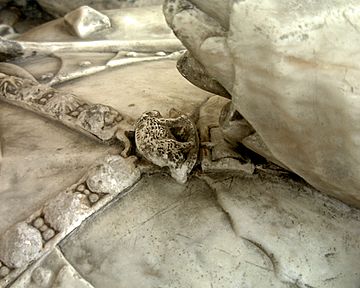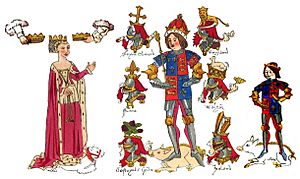White boar facts for kids
The White Boar was a special symbol, or badge, used by the English King Richard III of England (who ruled from 1483 to 1485). It's one of the first times a boar was used as a symbol in this way.

Badges like the White Boar were very important during the Wars of the Roses. They showed who you supported in the political fights. Richard gave out many of these badges when he became king and when his son, Edward, became Prince of Wales. Records show that 13,000 badges made of fustian cloth were ordered! Edward also used the boar symbol until he died in 1484.
Richard likely chose the boar because it was personal to him. Some old documents suggest the boar was a symbol for the royal estate called the "Honour of Windsor." An "honour" was a very large area of land. Another idea is that the boar was a clever play on words. "Ebor" was a short way to say "Eboracum," the Latin name for York. Richard was known as "Richard of York" before he became the Duke of Gloucester.
Boars in Ancient History
The boar was also an old symbol connected to the royal family's ancient roots. It was linked to the Galtung family, whose name meant "boar" in Norwegian. The Norse god Yngve-Frey had a "radiant" boar named Gullinbursti. This boar was super fast, like a horse. Because Gullinbursti was "radiant," boars were often shown as white, not their natural brown color. This white boar became a symbol of the Ynglinga family, linked to Ingi/Yngve-Frey. This connection goes back to Rollo of Normandy, who was an ancestor of the Plantagenet family.

Finding Richard's Boars Today
After Richard III died, the Tudor dynasty took over and made him look like a villain. Most of his badges were probably thrown away quickly. Only a few examples have survived. One is a white boar pendant on a Yorkist livery collar carved on the alabaster statue of Sir Ralph Fitzherbert, who died in 1483.
Some metal badges, which people would pin to their clothes or hats, have also been found. These are made of lead, silver, and gilded copper. One special gilded copper badge was found at Richard's home, Middleham Castle. This one was likely worn by someone in his household when he was the Duke of Gloucester.
In 2009, a new silver-gilt boar badge was found near the Battle of Bosworth Field. This is where Richard was killed in 1485. This discovery, along with others, is helping historians figure out exactly where the battle happened. Dr. Glenn Foard, an archaeologist, said this silver-gilt boar was very important. He believes it was worn by a knight who rode with King Richard into his final battle. It was found near a medieval marsh, which fits the story that the king's horse got stuck in mud.
This badge was similar to another one, the Chiddingly Boar, found in Chiddingly, East Sussex, in 1999. That one is also silver-gilt, though much of the gold has worn off. Badges made of valuable metals like silver-gilt were given to Richard's most important supporters. There might have even been gold badges with enamel and gems for his closest friends, like the Lancastrian Dunstable Swan Jewel.
The White Boar's Legacy
The Richard III Society works to protect Richard's reputation. They use white boars a lot in their own symbols. The society was even originally called the Fellowship of the White Boar.
See also


